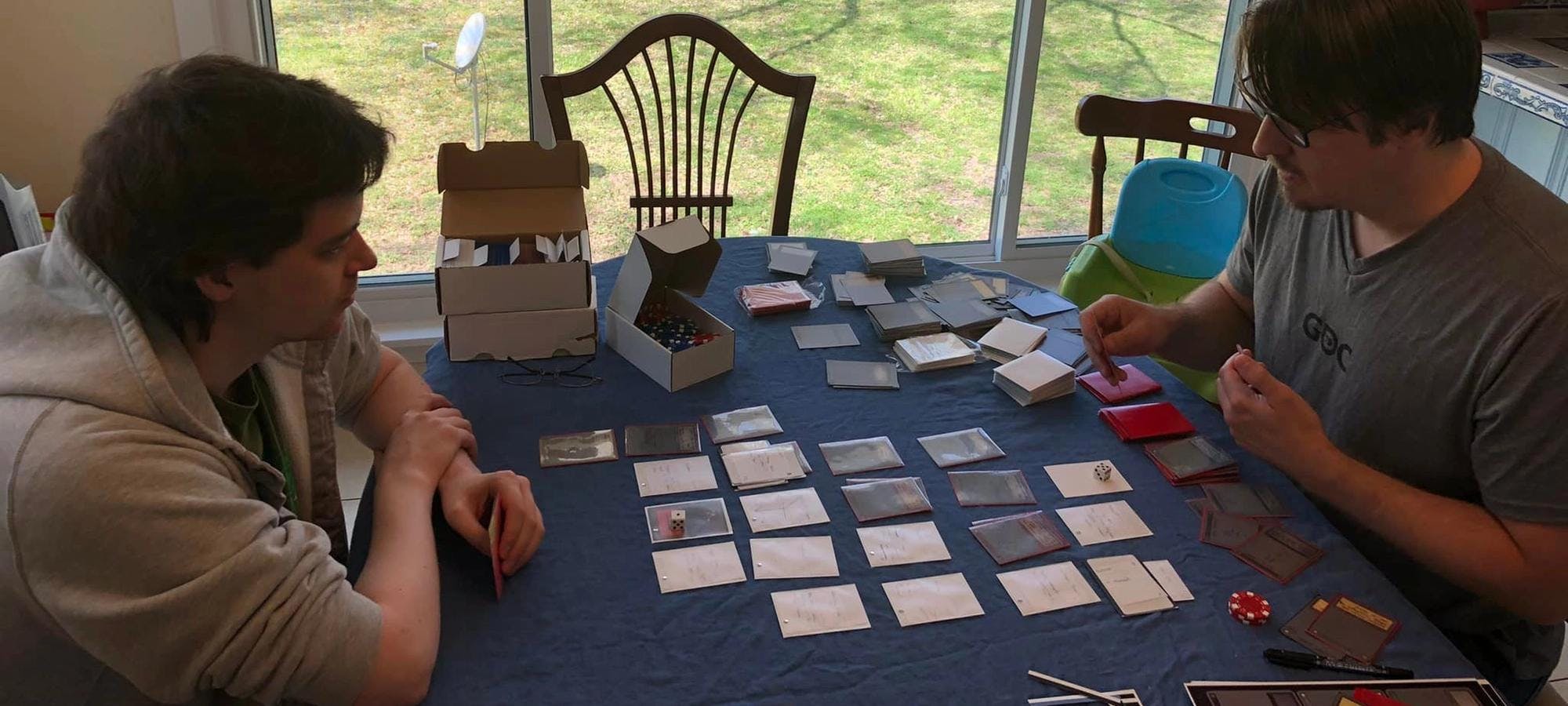
(Cross-posted from Collector Art House...)
I recently had the pleasure of connecting with Erik Olofsson for an interview that will provide some insights into Erik's background, and the birth of Sorcery: Contested Realm Trading Card Game (TCG).
The intent is to appeal to early adopter enthusiasts and those just learning about the project, alike.
The article is organized into four main sections. First an introduction, and then the three main "pillars" that compose the project's 'slogan' or 'mission statement' of sorts:
An "old school" fantasy card game for players with a rich imagination, tactical nerve and an appreciation for hand-painted art.
- Design Theme: An "old school" fantasy card game for players with a rich imagination
- Gameplay: tactical nerve
- Art and Card Design: Hand-painted art
I want to thank Erik for the opportunity, and his willingness to share some perspective on the background, direction, and future goals of the project!
Introduction
Mike @ Collector Arthouse: Tell us briefly about your background and how you got into Trading Card Games (TCGs).
Erik Olofsson: I'm a Game Developer, Creative Director and Collector of cards.
Like many a gamer my age my TCG experience started with MtG, and more precisely with the revised edition that got more widely spread around the world. There was something about the game that triggered the imagination, together with the collectability, and later skill testing aspect of it that really hit home with me as a teenager. I did play a little bit competitively and especially draft was my favorite format. I even qualified for a pro tour once. It was a team pro tour, and considering the team had people like the hall of famer Jens Thoren, maybe I got carried? :)
About that time computer games took over my attention and that branch of my life would keep me fully occupied for a good 20 years, but there was always a special place for TCG's in my heart and there was something about it that I always wanted to come back to.
Mike @ Collector Arthouse: You have had tremendous success with Grinding Gear Games (GGG) and Path of Exile (PoE). Why decide at this point in your life and career to move on from that to create your own company and your own TCG?
Erik Olofsson: Even if I worked with the art side of computer games for 15 years straight at that point I always saw myself first and foremost as an entrepreneur, so when I see a demand for something that I think should be created I have this thought process that starts in the back of my head that keeps swirling around and getting refined, sometimes over years.
This was a thought process that had been going on for years with this idea of a more casual TCG that would focus on iconic hand-painted art and awesome simple and clean designs. Some years back GGG got sold to Tencent which on one hand let us take things to the next level when it came to quality and budget, but it also meant not working closely and directly on the game itself. Working on a much smaller card game would allow me to do just that, take my headphones on and just get into the zone designing really cool cards.
Mike @ Collector Arthouse: In prior interviews you have mentioned that when you co-founded GGG and PoE, you felt there was a specific market opportunity for PoE to leverage the great aspects of Diablo II and enhance it with new innovative ideas. Do you see a similar opportunity in the current TCG market for Sorcery?
Erik Olofsson: Yes, there are several parallels between how Path of Exile and Sorcery was conceived and developed. One way of seeing it is that I learned a process of sorts from the development of PoE, and many of the experiences from that can be applied to other products. One thing I like about this way of thinking is that you don't need to have an idea that revolutionizes the world or creates an entirely new game niche. Building on something that you already know that people like is a much more grounded way of finding and developing new projects.
Design Theme
"An old school" fantasy card game for players with a rich imagination"
Mike @ Collector Arthouse: Tell us why you decided to take the “old school” fantasy throwback approach as a core thematic foundation for Sorcery.
Erik Olofsson: When it comes to Sorcery, I am heavily involved in the Old School MtG format, and the attached tastes of the players of that format. Collectability and nostalgia is intimately connected to the Old School format experience, so those are things you'd also see a lot of in Sorcery. I also think there is a timeless need for great art, and the art in Sorcery is more personal and evocative than the art in most games in my eyes, and from the Kickstarter success so far it looks like many people agree with me on this.
Mike @ Collector Arthouse: What design choices have you made that appeal to an “old school fantasy” sentiment?
Erik Olofsson: The first and most obvious one is hand-painted are in a wide range of styles. Art directors often strive to make everything look coherent and “perfect”, but I think that especially in a card game, a lot of the personality and sense of wonder and discovery can be lost with that approach.
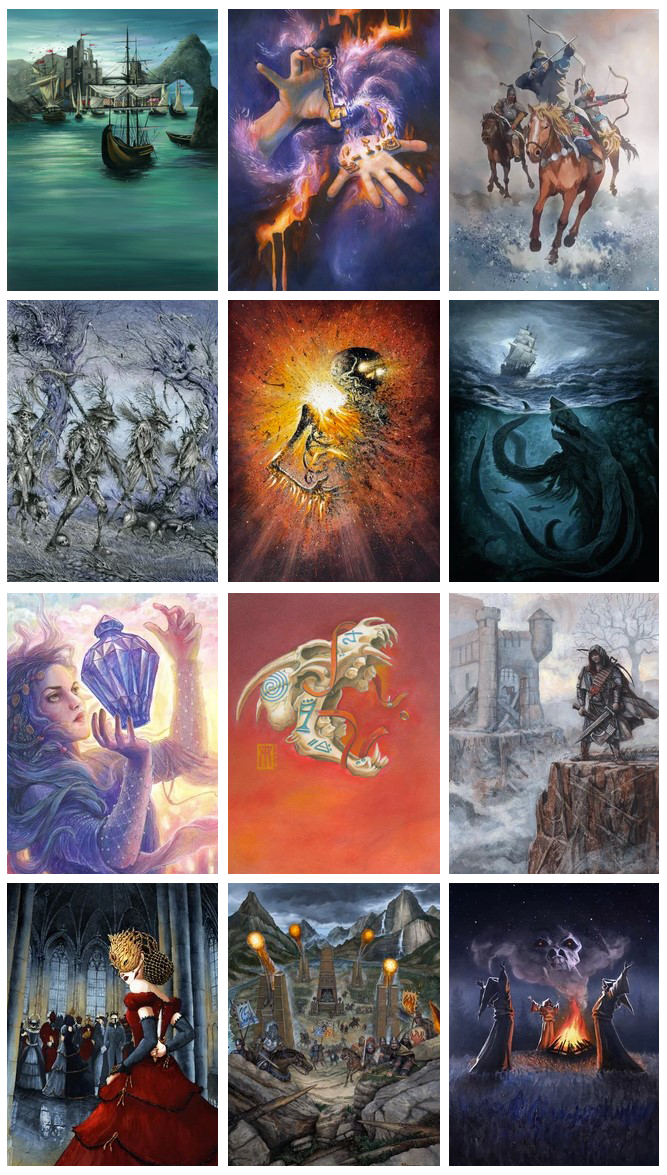
Above: Hand-painted art for Sorcery
Another thing that is important to mention here is that Sorcery is about the imagination of the artists and the players. We are are trying to create something evocative that lets players fill in the gaps with their own stories.
Taken to its conclusion the sense of discovery and adventure is something we want to be experienced through the booster opening experience itself. That's why the alpha set is so massive, and it is also why we will have many little small surprises in the form of curio cards in there.
Note: Sorcery's Alpha debut is expected to include over 400 cards; all with traditional hand-painted artwork. There is very little revealed about "curio cards". This is intentional to enable discovery through the pack-opening experience like the early 90s era of TCGs when internet access and ease-of-discovery via social media was less prevalent.
Mike @ Collector Arthouse: What do you think is the core target demographic for Sorcery TCG? Is it a certain age group, gamer type (e.g. board games, TCGs, both), collector type?
Erik Olofsson: We are basically creating a game for ourselves, which means we are making a game for people that lived through the golden age of TCG's. You don't have to be old like us to enjoy Sorcery, but if you are you will feel right at home from the beginning :)
People in the mid forties often have more limited time because of careers and/or kids, but the positive business case is that they have more discretionary spending potential for things like cardboard with pretty art on it. The game also does have more of a broad board game appeal I think, because of the tactical elements, and because of the overall very high quality art and narrative casual fun it allows for players that aren't necessarily your typical competitive players.
Mike @ Collector Arthouse: In the “old school” 90s TCG era, foil cards were not yet a prevailing norm in card design. Why did you choose to introduce foil variants in the Sorcery TCG Alpha set?
Erik Olofsson: I got badgered into it by people! :) No, it was clear that a lot of people enjoy looking at and collecting foil cards, and after thinking about it more I also realized we were in a unique position to create foils of great artistic quality. Many other games are forced to try to think of new bells and whistles for promo cards, but with Sorcery we are instead pushing the envelope on how well the artistic aspects of the foils have been implemented when it comes to things like silhouettes, contrast, choice of materials depicted, what focal points to bring to the forefront and so on.
Sorcery foils will have a very classic look to them that I think will hold up well for years, while they at the same time do things that haven't been done quite in the same way before. Making the foils have been a huge amount of extra work though, and I really hope people will appreciate them! I have come around on foils lately, and will collect a full set of Sorcery foils for sure!
Gameplay
"Tactical nerve"
Mike @ Collector Arthouse: It is interesting that MTG was such a strong influence for the game, but yet you decided on a fundamentally different gameplay approach with the grid-centric design. What led you to this decision?
Erik Olofsson: At the very beginning, the game-play was actually very similar to the MtG style game engine, with some minor tweaks to expand the possible room for game design. The square grid is something that got pitched to me by Nick [Sorcery's co-founder], and in the very first game there was great and fun things happening.
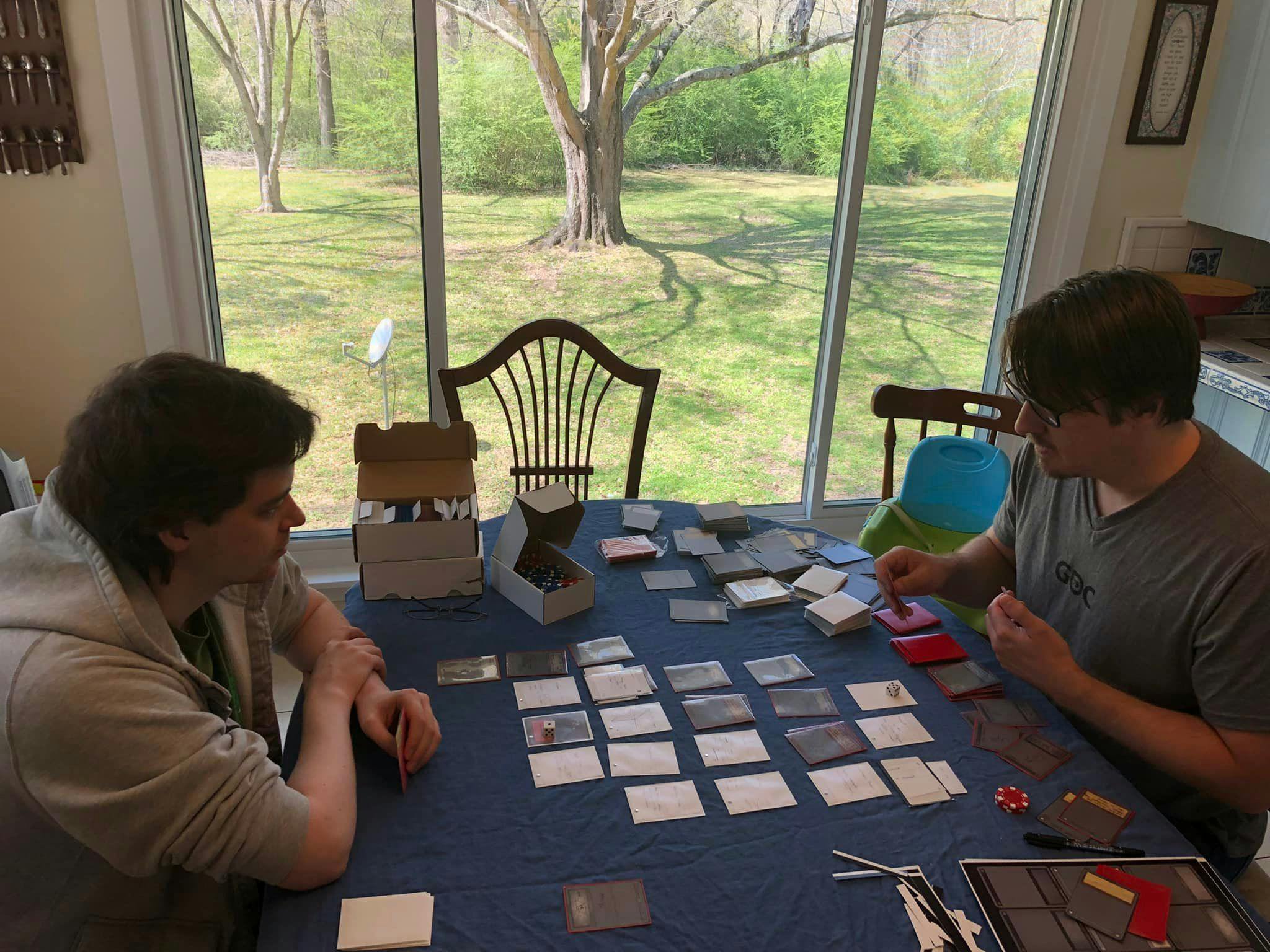
Above: Co-Founders Erik Olofsson & Nick Reynolds First Gameplay Encounter
I remember a Cloud City floating around carrying minions behind enemy lines. Nick also had classic cards like what now is Pudge Butcher in there, as well as “Hot Potato” (now Devil's Egg), and it was great to see the tactical impact that cards like that had. The game at that time was still very different from what Sorcery looks like today, but I think it was obvious that Nick had great fundamentals in place so we just went with it from then on.
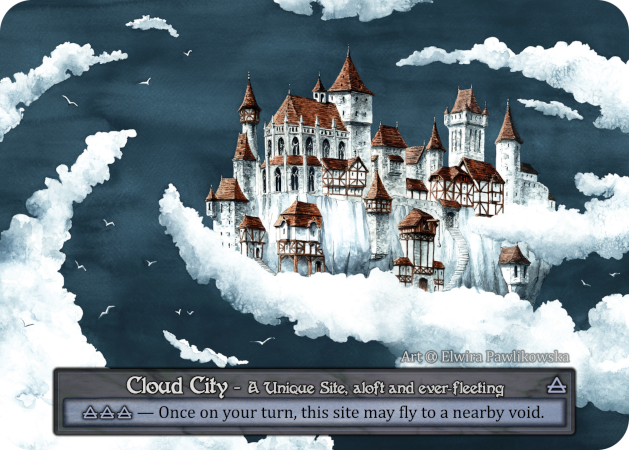
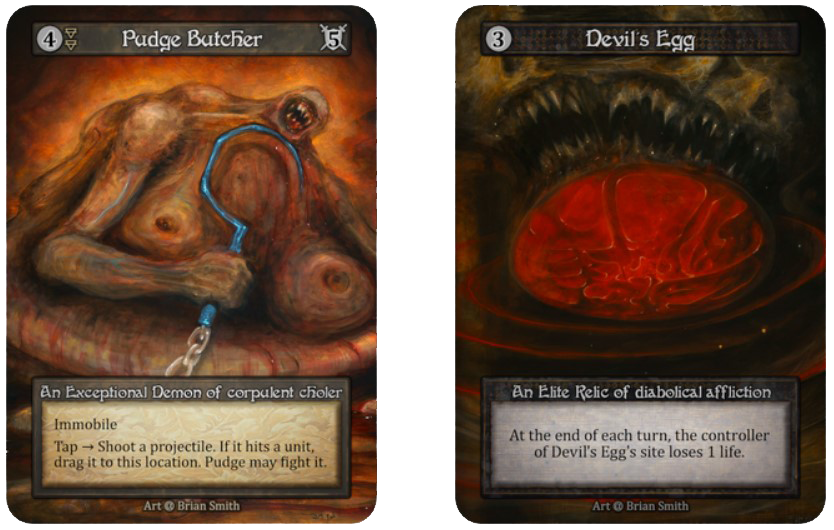
Mike @ Collector Arthouse: Are there any grid-centric games or board games that have provided some influence or inspiration for Sorcery?
Erik Olofsson: We were actually not so aware about other square grid games at this point, and it even felt like I found a new game every week that shared some similarities. There seems to be tens, if not hundreds of older square grid card games that aren't played much nowadays. When this kept happening (the discovery of “dead” square grid games), it was a bit worrying. Was there something inherently impossible about designing a viable square grid TCG?
When looking closer at many of these other games I could not help thinking that they had big design problems. Sorcery was both easier to learn while still taking even more advantage of the possibilities that the square grid offers for design space. And this is something that only was improved on over the years.
Mike @ Collector Arthouse: Describe “tactical nerve”. What does the term mean to you?
Erik Olofsson: The square grid offers so much variation in how positioning matters. This goes both for sites and minions. The game is very deep and requires a new and fresh set of skills and anticipation for players to master. Where should I play this site? Should I place my minion defensively or offensively? There are a lot of subtle decisions that create a very “easy to learn, hard to master” game. There's always a lot going on since there are so many angles of attack, and the game has a very swingy and fun feel to it where games are often very close with a clutch finish by one of the players.
Mike @ Collector Arthouse:A grid-based approach can add tremendous complexity to a game, but it appears you have done very well to strike a balance between ease to learn the game while also preserving great tactical and strategic depth. Can you explain a bit how you approached striking this important balance?
Erik Olofsson: A lot of effort has gone into keeping the board state understandable and “clean”, while still not destroying the soul of the game. Don't get me wrong, Sorcery still can get very ridiculously complicated situations if both players play the role to achieve it!
For example the playing field size did shrink quite a lot over time to shorten and simplify games, and sites were changed to use a landscape format that made them easier to separate from the cards that were positioned on top of them.
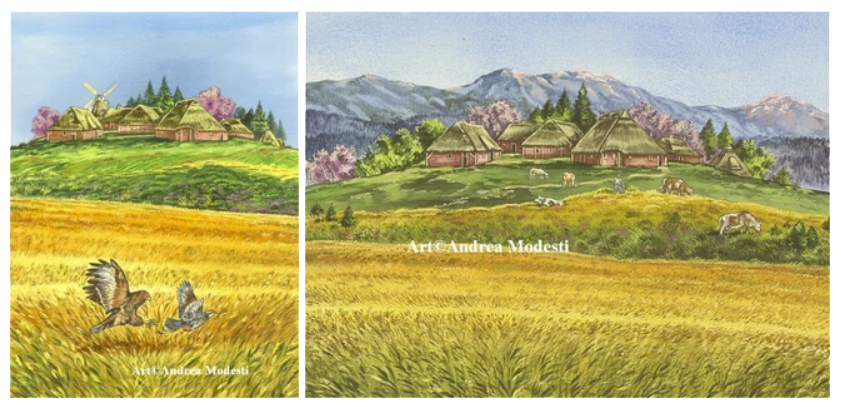
Above: A "site" original painted in 'portrait' style and redone in landscape format
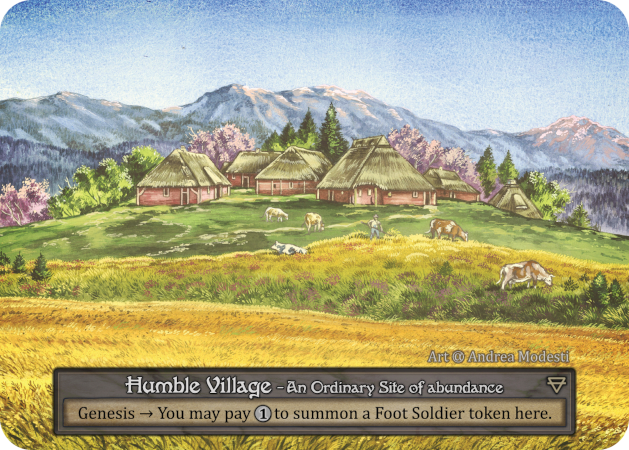
Above: The final version of site cards
Another more subtle simplification of the game state came from having sites mostly provide an effect as they enter play, and not a permanent effect.
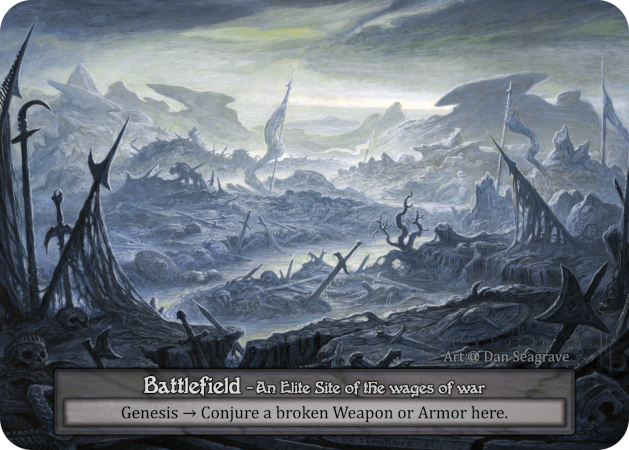
Above: The "Genesis" effect triggers an effect as it enter play
Apart from this, we took our time to develop the rule book and card text to to be simpler and more streamlined. Keywords were simplified, card themes were distilled down getting the core of their design through in a clean and simple way, and things were tested and tweaked to be easier to understand.
Art and Card Design
"Hand-painted art."
Mike @ Collector Arthouse: What are some of the factors that went into your decision to use all hand-painted artwork for Sorcery?
Erik Olofsson: Games that I really remember from my early gaming days were all using hand-painted art where artists had their own personal style and I think there is something evocative and special that was lost since then. I was also at the time already commissioning art from some artists that were big in the '90s era, both art that wanted on my walls and art that I wanted for my MtG art proof collection. Going with all hand-painted art was a natural step.
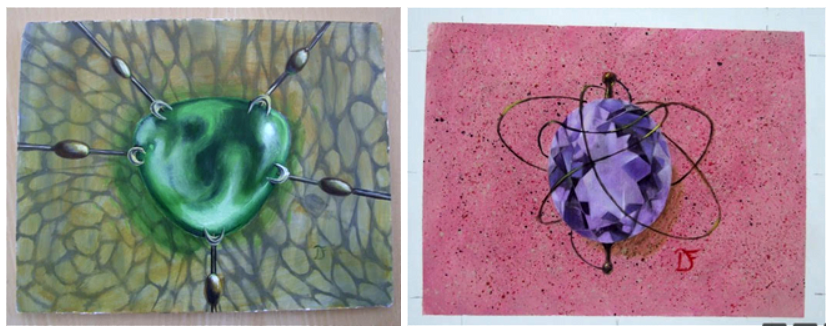
Above: Art commissioned from Dan Frazier of MtG fame.
Mike @ Collector Arthouse: Can you describe your approach to card design?
Erik Olofsson: Especially for alpha, most cards are done with a top down design where where we look at fantasy tropes and then imagine how they can fit into the Sorcery framework. For example how does a Sea Serpent function? Well, it can submerge itself under the surface of water sites. How would a Basilisk work? It petrifies minions on the site it looks towards at the front of it. However some cards do start in the other way of the spectrum where a specific effect in the game is needed. An example of this is Polar Bears, where the goal was to create cards with abilities that “close the gap” between players fast. In this case the name and flavor was created after the game-play effect.
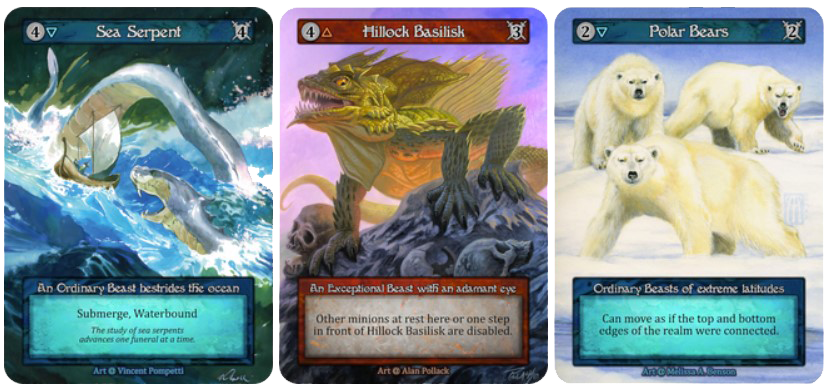
Regardless of what the starting point of the design is, we try very hard to get a tight correlation between the title, artwork, type line, rules text and flavor text of cards, so that when you look at a card and see the name and art you hopefully have a good idea of what the card might do just from that.
Mike @ Collector Arthouse: There are so many design choices and attempts by various companies and games to experiment with card design layout. Can you give us some insight on some of your card layout choices and how you arrived at the final card template?
Erik Olofsson: Simplify, simplify, simplify! The graphic design of Sorcery very much puts the art in the focus, both by giving it a lot of space, but also by not having many other colorful and and high contrast elements that competes with the art.
Mike @ Collector Arthouse:There is such great artistic style diversity in Sorcery, and yet it all seems to come together so cohesively as a ‘set’. What was your process for selecting artists and specific artistic styles for the debut set?
Erik Olofsson: Firstly I am a fan of specific artists that I enjoyed in my early days of gaming, and it's been a great honor to be able to work with several legendary artists on this project. Its the kind of thing I'd never think would have happened earlier in life. One of the steps leading up to the creation of Sorcery was actually me having some art commissions done in an old school style, for the sake of the art itself.
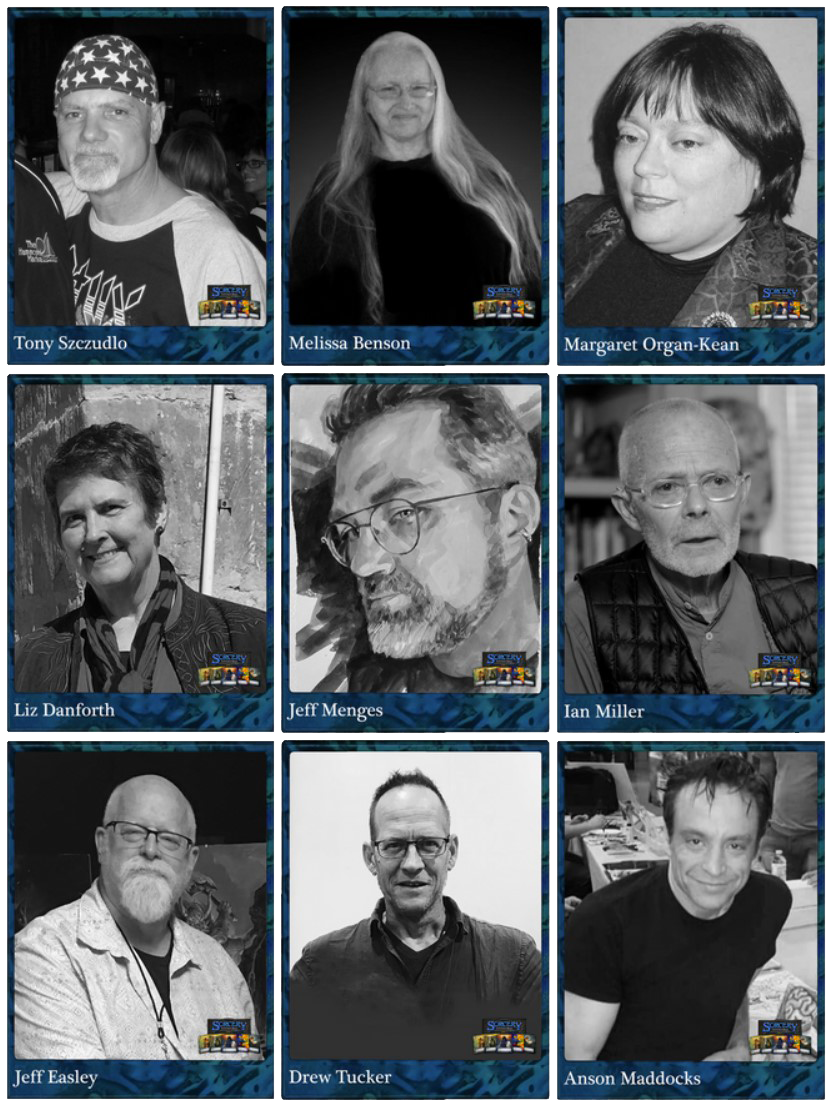
Above: Some of the titans of the golden age of TCGs commissioned for Sorcery
I have also been specifically looking for people that have a personal style that is distinctly theirs. Most art direction in games aims to reduce and take away the distinction between artists in order to create a consistent style throughout the game, but Sorcery instead embraces it. The upside from doing this is that players both get to enjoy much more variety, but also that cards get more recognizable and easier to tell apart. You don't just have the color motif, you also get the personal style of the artist and the medium used (oil, water color, pencil and markers, a mixed media) as well.
~ Follow Mike from Collector Arthouse at his various platforms conveniently located here.
Share:
